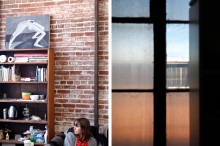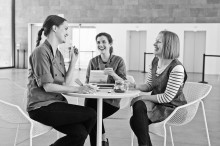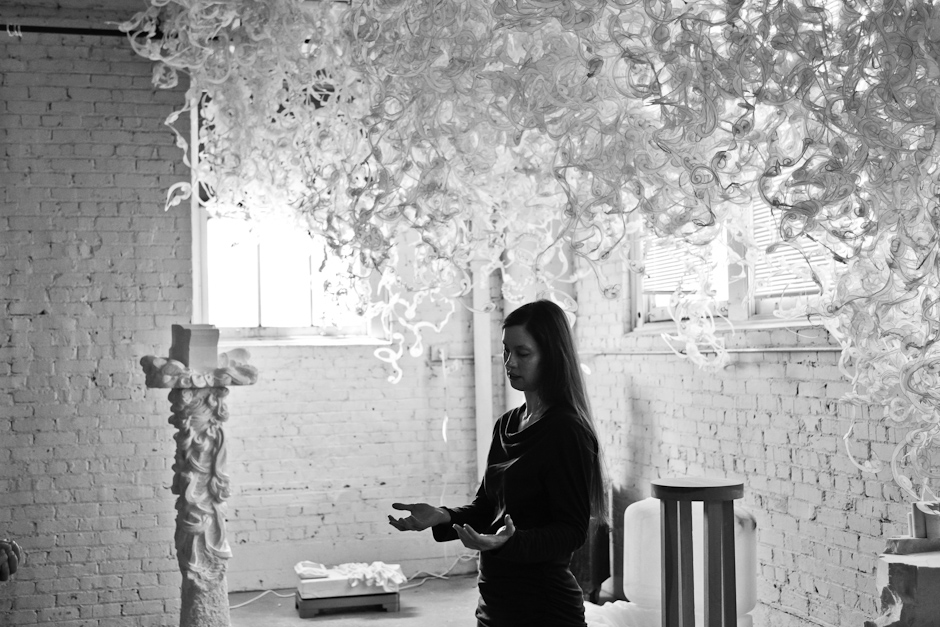
Marie Sivak
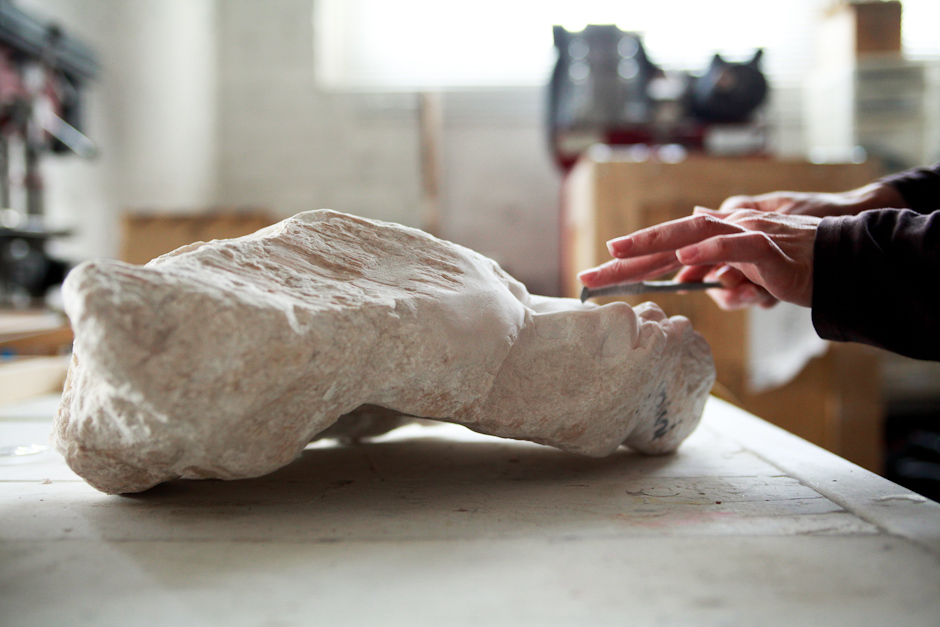
In her interview with us Marie shared a Jean Arp quote: “The content of a sculpture should reveal itself on tiptoe, without pretension, like the track of an animal in the snow.” It’s a simple statement, yet so visually rich, so delicate and precise in word choice, and so explosive in meaning. I loved that Marie chose to share that quote because in many ways it acts as a point of access to her own work.
We visited Marie in her Portland studio in an industrial area right near the Willamette River and immediately I was awestruck by the palette of her space— it’s all creams, ecru, dusty grays, and beiges, and shadows and light stretched out against the white brick walls, changing shape ever so slightly throughout our visit. It was calming and a little eerie at the same time, almost the way dreams or memory can be. In fact, one of Marie’s main preoccupations in her work is the exploration of the complex and elusive world of memory and the ways in which we attempt to establish steady footholds within it. Using a variety of materials besides stone, she creates mixed media pieces that bring both personal and collective memory and meaning to the forefront to provoke a collision of time, emotions, and space for the viewer— past, present and future are muddled, familiar objects are transfigured, and grief and elation coexist.
One of the most magical aspects of Marie’s work is how she has combined video with stone sculpture— her piece Memoir is a great example in which video is projected onto an alabaster carving of a book, and so it appears as if a woman is writing from inside the book. Another of her more recent sculptures Floating Remnants or The Lingering Sting (which shows a bee trapped in an alabaster envelope) reveals a new direction. In these works the video imagery projects from within the sculpture, through the stone, onto its surface, creating luminosity and a particular buzzing, building, moody atmosphere.
Marie’s work is like that— it builds up quickly within you and around you, initially entering softly, light-hued and fragile despite the weight of its materiality, despite the heaviness of its ideas… but it has an immeasurable density and layers that would take forever to peel back.
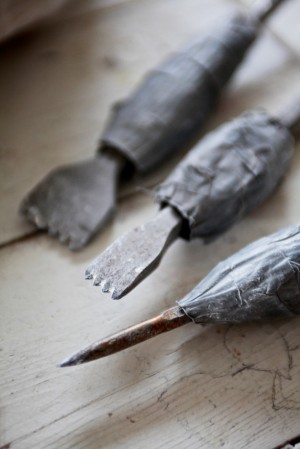
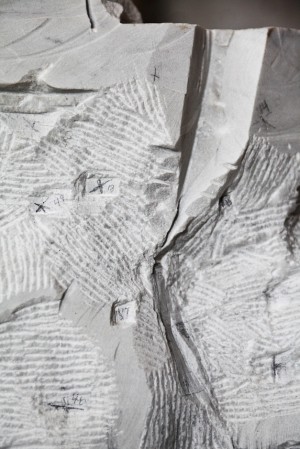
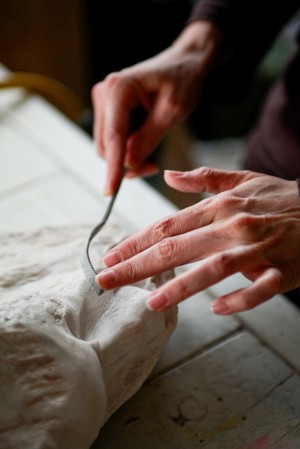
How would you describe your subject matter or the content of your work?
My work provides a poetic and analytical platform where objects and environments act as portals through which we may access the world of the sublime. I seek to reunite the intellect with the emotions; to know intangible ideas by giving them concrete form. The focus of my recent and current projects has been the psychology of memory and language as well as the role of the individual’s experience within society; how personal experience has greater cultural implications. Aesthetically, My work leans toward the poetic, but within it there are hints of socio-political realities.
The Comfort Food is a piece made from materials such as hospital sheets, gauze, and shredded health insurance documents that confronts the experience of losing my partner— it was a life altering event and as horrible as it was to lose him it opened up many complex emotions. I began to relate experience more to intellectual pursuits, and to realize that the emotions are more prevalent in scholarly work than people want to admit. It made me realize that the personal is important in art, and I’m not going to back down from that. I feel like the art world doesn’t always welcome the personal in work— of course it depends on what realm of the art world we are talking about… but if we are looking at contemporary trends in the art world there often seems to be an aversion to work that isn’t cool enough in terms of emotional content. I believe personal experience brings an incredible amount of honesty to art. For me, it is what makes art powerful, and successful as art. I’m not saying that every single thing that happens to a person is of interest to the rest of the world, just that allowing oneself to be driven by personal life experience involves risk. Anyways, I suppose in regards to my own practice I’ve gotten to a point where I just feel like, “Well, I’m not turning back now.”
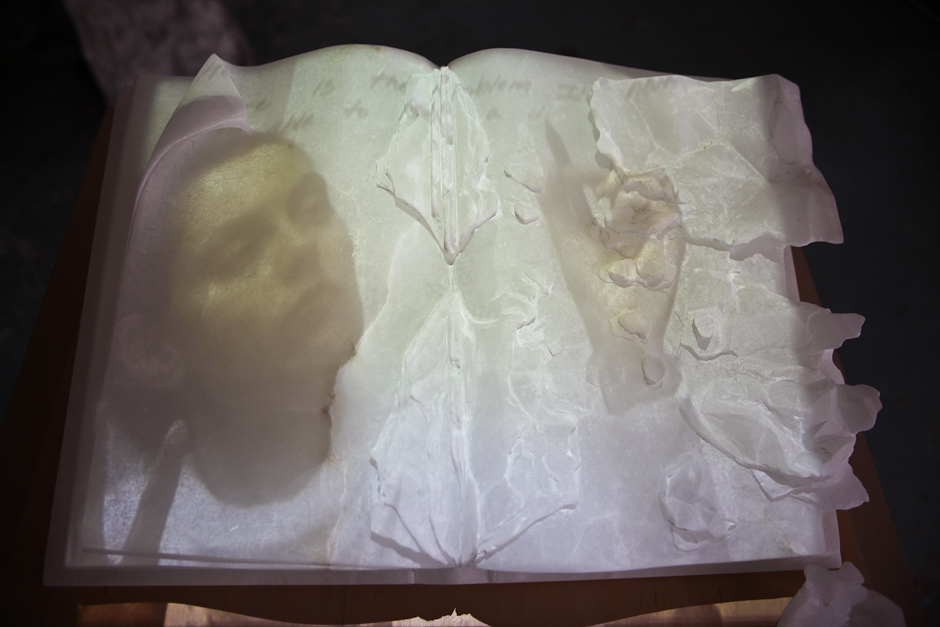
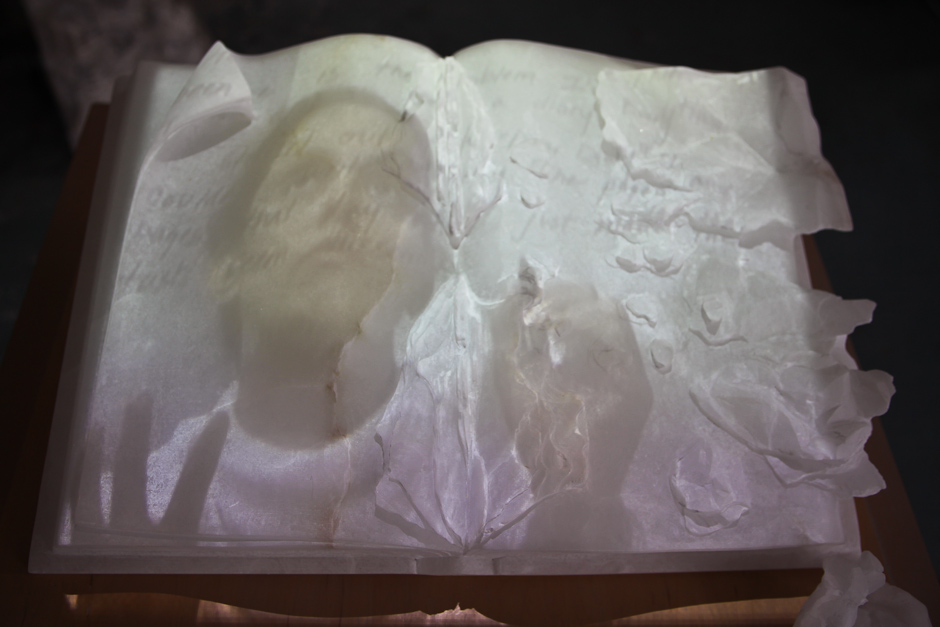
What mediums do you work with?
The juxtaposition of materials creates the grammar of my work: salt and organza, hematite and silk, rare earth magnets, stainless steel, thick layers of graphite and ink on paper, video and stone. Materials have personal and collective meaning; salt bears a wealth of paradoxical associations. It is the only rock we eat; it is necessary to our survival but it is poisonous in large quantities. It is the substance of tears and is therefore linked to grief. I often use nylon organza with different forms of stainless steel to create flaccid structural systems. My intuitive process resembles the form finding approach of architects such as Antoni Gaudi and the engineer Frei Otto. The installations can be conceived as a “state” or “condition” in terms of an open structure in time and space. When juxtaposed with sculptural objects they suggest the architectural lattices of memory or a pattern of thought. Most recently I have been mildly obsessed with combining video and stone sculpture. Initially I started working with video in graduate school because my work was so ephemeral— it was a way of preserving and documenting. After school I continued to work with both video and stone sculpture simultaneously, but hadn’t anticipated that the two would intersect.
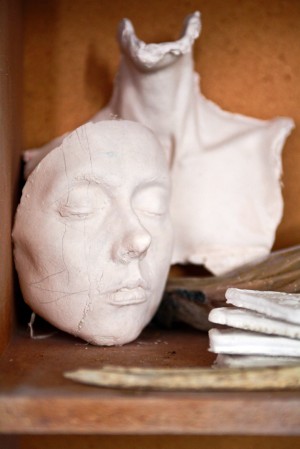
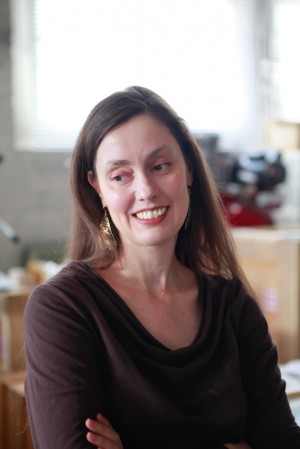
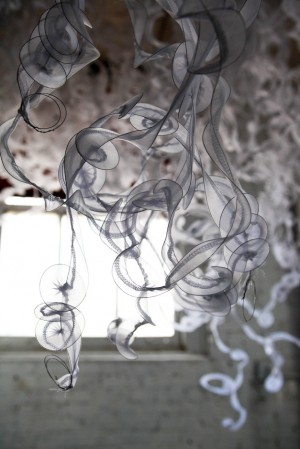
You have an art practice that employs an array of materials and mediums— how do you think this benefits your body of work overall? What are the pitfalls?
I think the work is richer conceptually because of the media I use. In the last 10 years I have been fascinated by the conceptual and expressive possibilities of combining video with traditionally carved stone objects. The power of the hand worked object, the labor that resides in the carved object can be felt physically by the viewer. I think people have a kinesthetic response to objects that have been touched so much by the hand. But I also love technology, not for technology’s sake but for what it can bring to the experience of the work. The real time of video and the option of being spontaneous that this medium offers is a counterpoint to the lengthy labor of crafting objects. I can draw from Renaissance and Baroque sculpture while also responding to the history of film and performance art.
The pitfalls are that it is much harder and takes a lot more time and money to work all these media together and to feel I have time to create all the ideas occupying my mind. I can easily spend a year making one sculpture – and in some cases more than that. An installation and a body of work can take 4-5 years. It can be frustrating. One of my goals with this next body of work is to find strategies to make the physical labor more efficient and have more spontaneity. It is also a real problem organizing my work spaces. Video, fiber based installation and drawing are not very compatible with the dusty process of stone carving! Right now I have three separate places where I work: outside at my house, in my studio in town during the winter and a room in my house where I do clean work like shooting and editing video, drawings, fiber installation elements and view work in progress. I am hoping to consolidate to one site in the near future so interfacing between media becomes easier and more fluid.
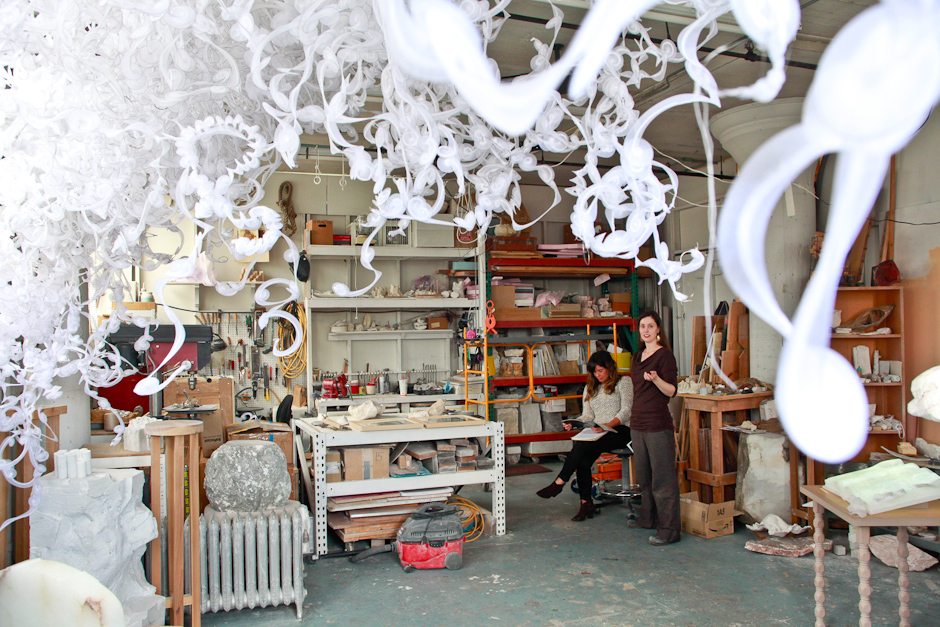
You have said that hand made objects are “magical tools for understanding the human condition.” Can you please further explain this notion?
It is not just the hand made; it is the hand made combined with technology that allows me to use sculpture as a way of contemplating experience and relating it to greater philosophical concerns. By experiencing a sculpture with a real time element whether an imagined act such as using a pair of scissors to cut a thread or the suggestion of a concept through filming ritual performance the viewer has the opportunity to place the emphasis on experience and relate that experience to their own. Bill Viola, Peter Campus, Carolee Schneemann, Andrei Tarkovsky used the moving image to explore the philosophy of being in a psychological and experiential way….I share those concerns and use my work as a way of meditating on experiences that raise questions in these realms. For example, one of my recent works called Memoir is about this fascinating experience of feeling a sense of remoteness and intimacy while reading a book. The piece collapses the experiences of writing and reading into one instant, compressing time and space. The page of the book is both a window and a barrier. It explores the need to write one’s memories and thoughts even if they don’t survive. It is also about the human desire to create and put oneself (literally or not) into a work of art. The sculpture is a springboard for meditating on multiple implications, generated by the transient act of writing and reading and what it means to connect to another human being via the form of the book.
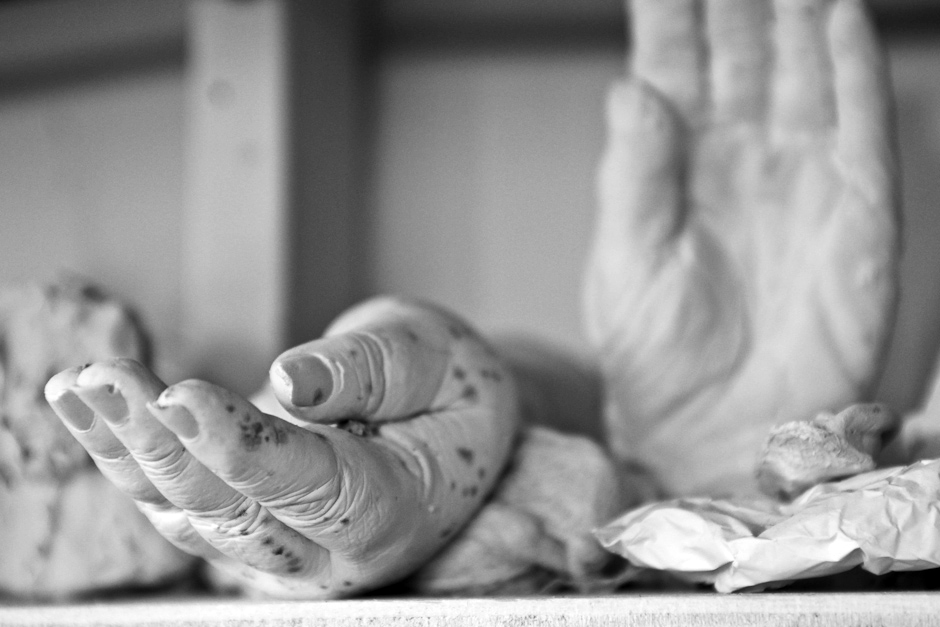
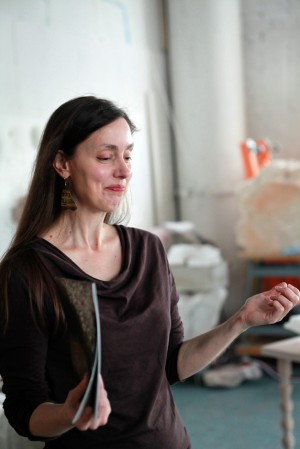

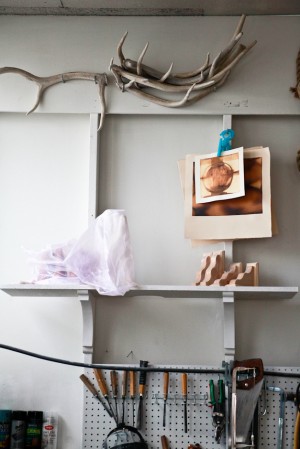
What influences outside the visual arts inspire and impact your approach to making work?
Reading has always been an important influence on my work. I love novels that explore ideas as experienced through the structure of the imagined experience. Among my favorite authors are Francesca Duranti and Italo Calvino. I just finished two great books by Ivan Doig…The Sea Runners and The Whistling Season. I like stories about ordeal or a journey where the landscape is described to a point of meditation. While perhaps not always overtly a part of my work, landscape, especially that of the Pacific Northwest influences what I do. Landscape is a kind of architecture that is built in to remembered experience. I love hiking and exploring new landscapes; it’s a part of my creative process. I also enjoy reading thematic history. Mark Kurlansky’s Salt: A World History, and the one about cod fish remain influential as a way of understanding cultural implications of materials (I have used a lot of salt in my work at times).
Science is another topic that greatly influences my work. Descartes’ Error by Antonio Demasio is a book that I read passages in again and again. My all time favorite though is Eros and Magic in the Renaissance by Ioan P Culianu. This book investigates the trajectory of changing ideas of spirituality in relationship to the historical path toward modern science, how the Greeks viewed the idea of the “soul” versus post enlightenment ideas of the soul. My husband, Dan has a background in Math, Neuroscience and Computational Biology; we love to talk about culture and science.
Right now I’m doing research on digital tools and machine technology to see where these technical realms might have a place in my art practice. I’ve used digital video editing a lot. The sculpture I’m working on now is going to incorporate sound design. I’m learning about Auto Cad, CNC machines, rapid prototyping, and interactive technology. I’m excited about inserting the “Art” within STEM (an acronym for the fields of study in the categories of science, technology, engineering and mathematics) initiatives to change it to “STEAM” so that students can become more accustomed to creative thinking. I think a lot about STEAM and how it relates to my own work.

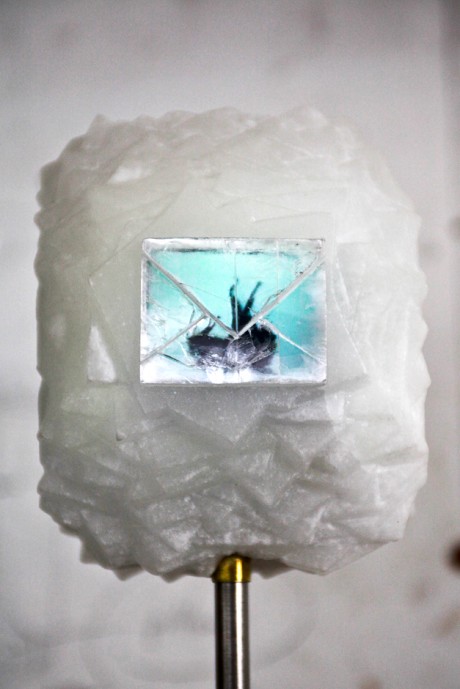
What does having a physical space to make art in mean for your process, and how do you make your space work for you?
Having a space that reflects my thoughts, a room that is a metaphor for my own mind is essential. Virginia Wolf’s essay A Room of One’s Own resonates. I need to see my work and have a place where I can shut the door and reclaim my autonomy of thought from the everyday demands of my job and my life. I am anything but a post studio practitioner of art— I have to have a studio (or in reality studios). Making my space work for me has been a struggle due to the diverse media I use.
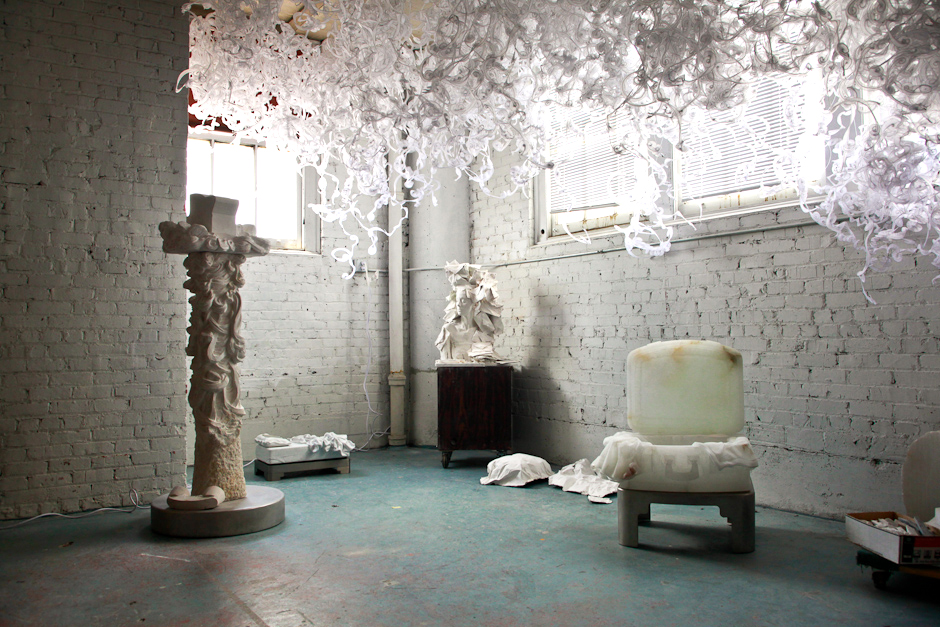
Is there something you are currently working on, or are excited about starting that you can tell us about?
About 10 years ago I began thinking of ways in which I could incorporate video with stone sculpture. Pneuma and Memoir combine video with alabaster, a translucent stone. When video is projected onto the stone the material absorbs some of the light resulting in the sense that the imagery is illuminated from within the stone.
The most recent sculptures (Floating Remnants, Vicious, and Aftermath) represent a new direction. In these works the video imagery projects from within the sculpture, through the stone, onto its surface. Embedding video inside the sculptures is technically challenging, time and labor intensive, but its conceptual and expressive magic makes it hard to resist. Video rendered through stone is transfigured into gentle, luminous gestures.
Currently I am continuing to explore ideas that involve video projecting from within objects carved in limestone, marble, and alabaster. Aesthetically, the carvings involve fragments of figurative imagery, (the feet, faces, hands) interlaced with abstract organic forms and objects used to connect human beings to each other, strings, cords, quills, letters, telephones… I am really non linear in my process and often develop several veins of thought especially at the beginning of a new cycle of work. Eventually I hone down to a group that feels unified and conceptually intertwined.
The largest project that is the most developed at this point is an abstracted telephone perched on top of a column of tangled cords carved in limestone. There will be a video embedded where the rotary dial would be. The piece is about the kind of phone call that we all receive at least a few times in our lives. When the phone rings you can almost tell by the ring that whatever is said, as transient and incorporeal as it may seem, will completely change your life in a very permanent way. I’m really interested in how intangible and ephemeral moments can create a lasting, even a physical response. Can a phone call literally disconnect you from yourself? Although I have been recording sounds off and on, this will be the first sculpture that will involve sound. I have a whole library of sounds I recorded myself at the different places I have lived in for the last 14 years. I am going to begin recording sound at my current home in the Tualatin River Valley soon. My plan is to create a soundscape that in combination with the video imagery will explore the relationship between place and identity, psychological distance, and the alteration of interior emotional terrain over time. The sounds will move from urban to rural as I have, the seasonal changes being reflected by the atmosphere, different birds and animals, or street sounds.
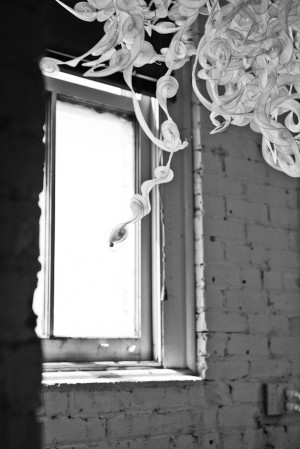
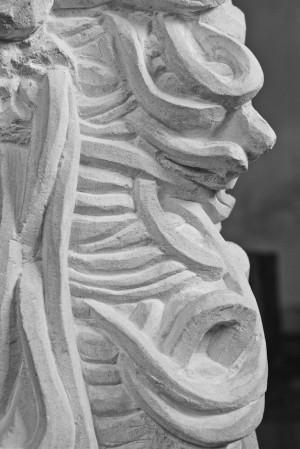

How do you navigate the art world?
Well, I do my work, I apply for shows. I am especially dependent on grants. This might sound odd, but I actually enjoy writing grants; its part of my creative process. The process of writing helps me pin down my goals and subject matter. More recently I have been far more proactive in getting my work out there. I just received last year, Career Opportunity Grants from The Oregon Arts Commission and The Ford Family Foundation which I used to produce a 24 page full color catalog of my work with an essay by Charlotta Kotik, Curator Emeritus of the Brooklyn Museum. It took me a long time to understand what is important to me as an artist and to feel ready to seek more visibility; the work comes first. Working with Charlotta made me realize how important it is to bring people in the art world into my studio, to have a dialogue, and to be part of this experiment that is contemporary art.
Words of wisdom?… a motto, favorite quote?
“The content of a sculpture should reveal itself on tiptoe, without pretension, like the track of an animal in the snow.” Jean Arp
Being in artist is not an easy endeavor; three words, well I guess 3.5 words— “don’t give up. “
“If you are not being rejected; you are not trying hard enough.” One of my professors in grad school at Virginia Commonwealth University gave me that little gem. I think it was Lester Van Winkle. It reminds me to just keep going.

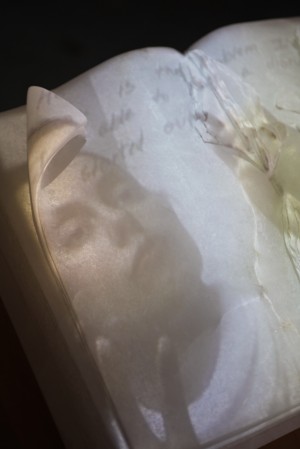
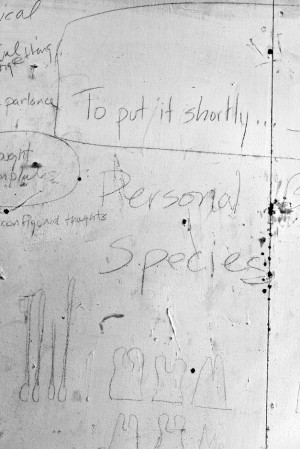
Are you involved in any upcoming shows or events? Where and when?
I have a solo exhibition titled “Tenuous” from January 8th-February 14th, 2014 at the Dan and Gail Cannon Gallery at Western Oregon University. The reception is from 3:30-5:30 pm Wednesday, January 15th. I’ll be giving a lecture on February 5th, 2014 at 3:30 pm. .
Recently I did a show at the Archer Gallery at Clark College in Vancouver, WA and finished a major exhibition at A.I.R. Gallery in Brooklyn, New York. I was also in the Oregon Biennial which is organized by Disjecta and travelled to the Schneider Museum of Art in Ashland, OR.
Future exhibitions are in the works— I am doing research and raising money to continue work on some ongoing large scale projects and a new body of work. I am happy to say I am off to a good start! I am the 2013 recipient of the Margo Harris Hammerschlag Award. Created by the National Association of Women Artists in New York, this $10,000 prize is for a woman working in direct carving. I am thrilled to have been selected.
To see more of Marie’s work:
www.mariesivak.com
www.airgallery.org
Visit these links for videos of her work:
See a short video on her process here.
See documentation of video and stone sculptures here and here.



